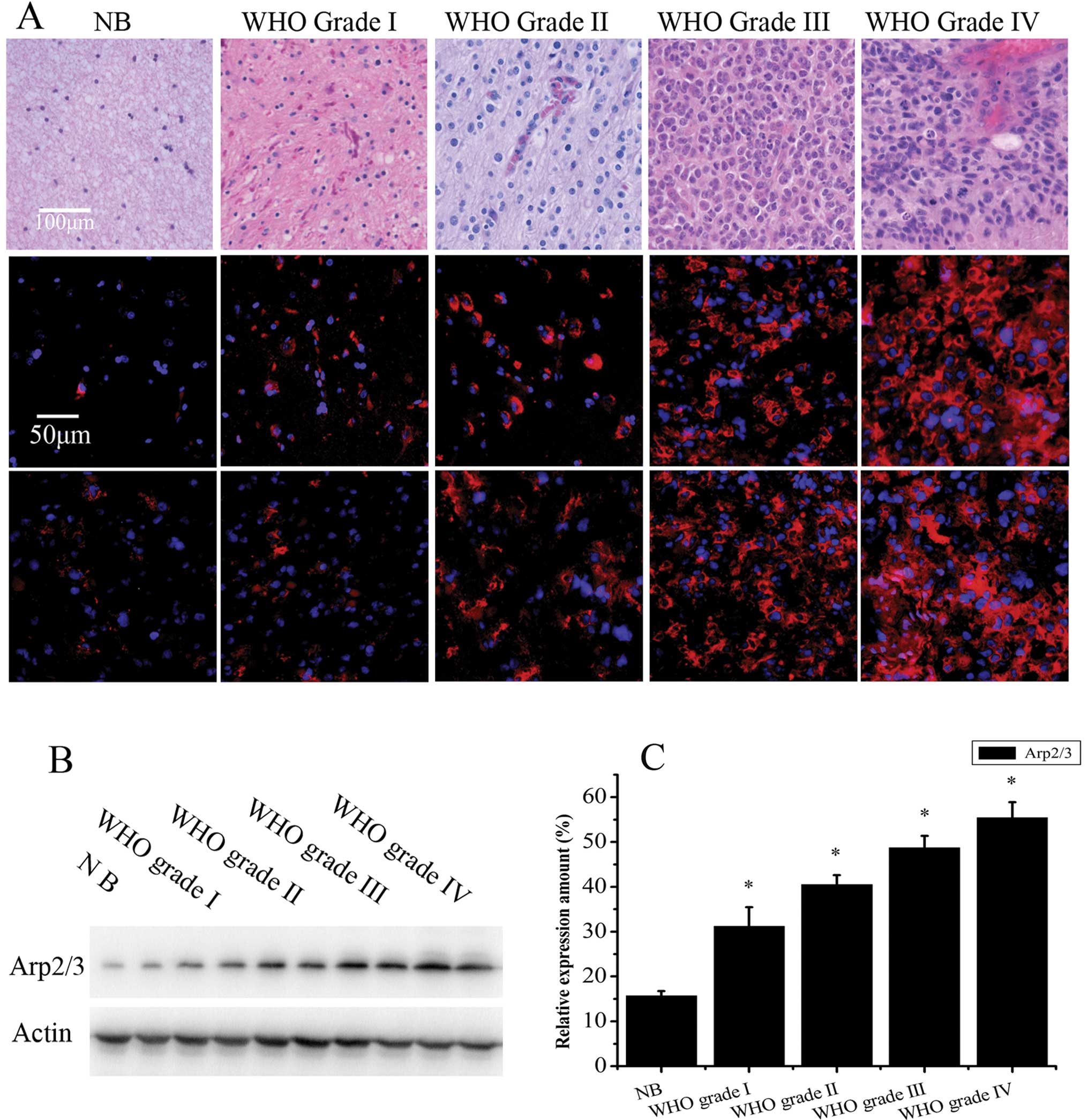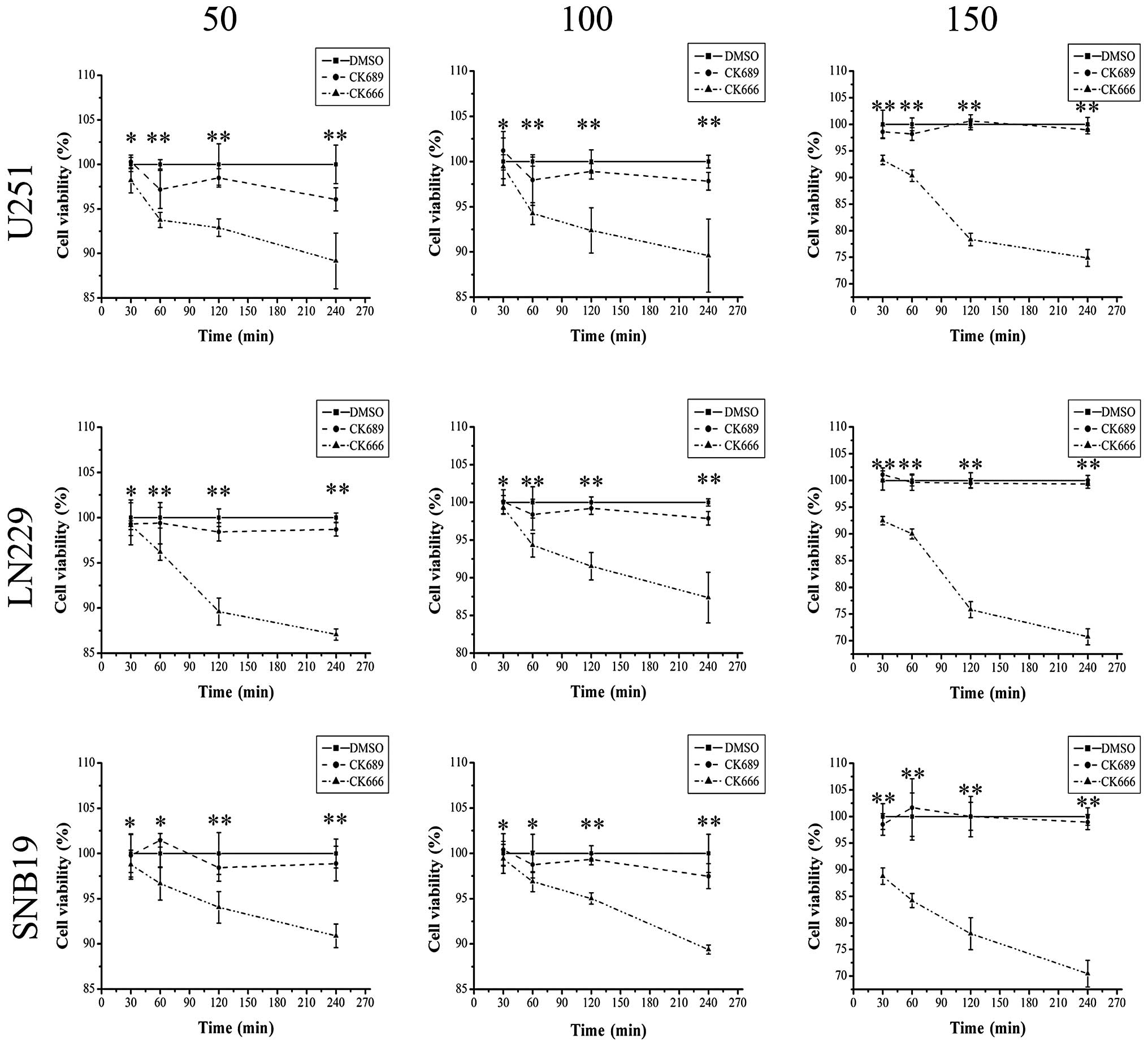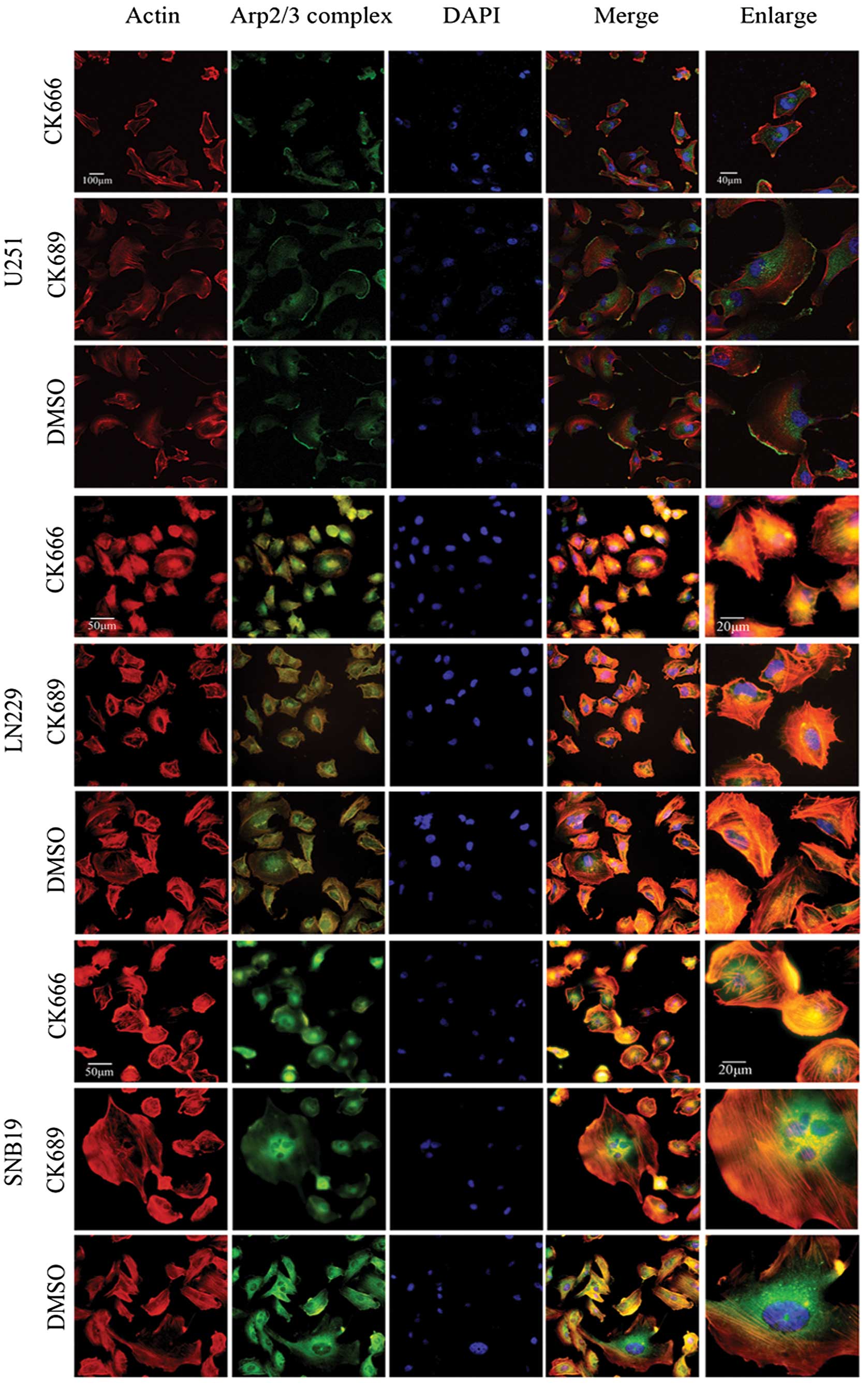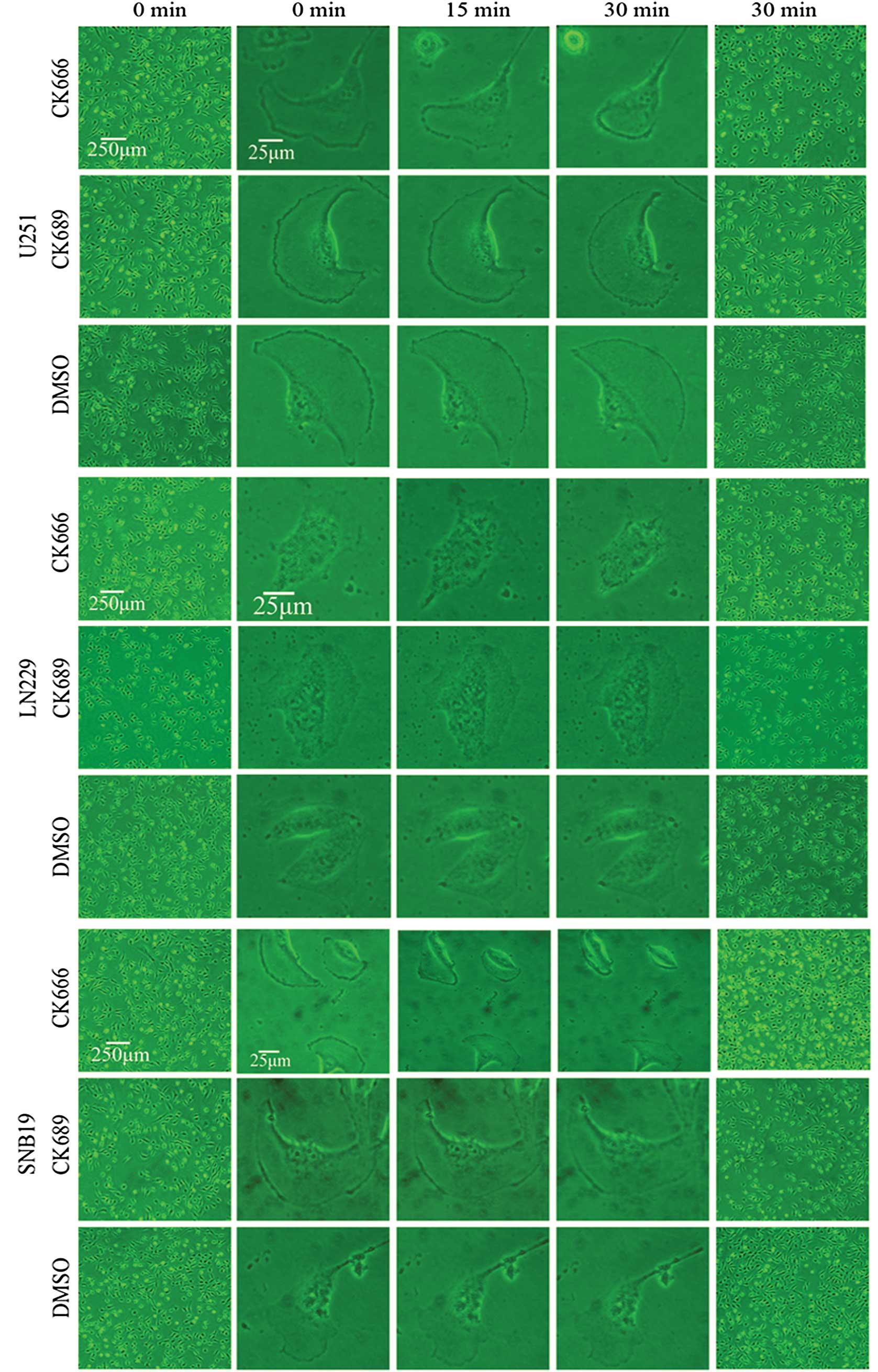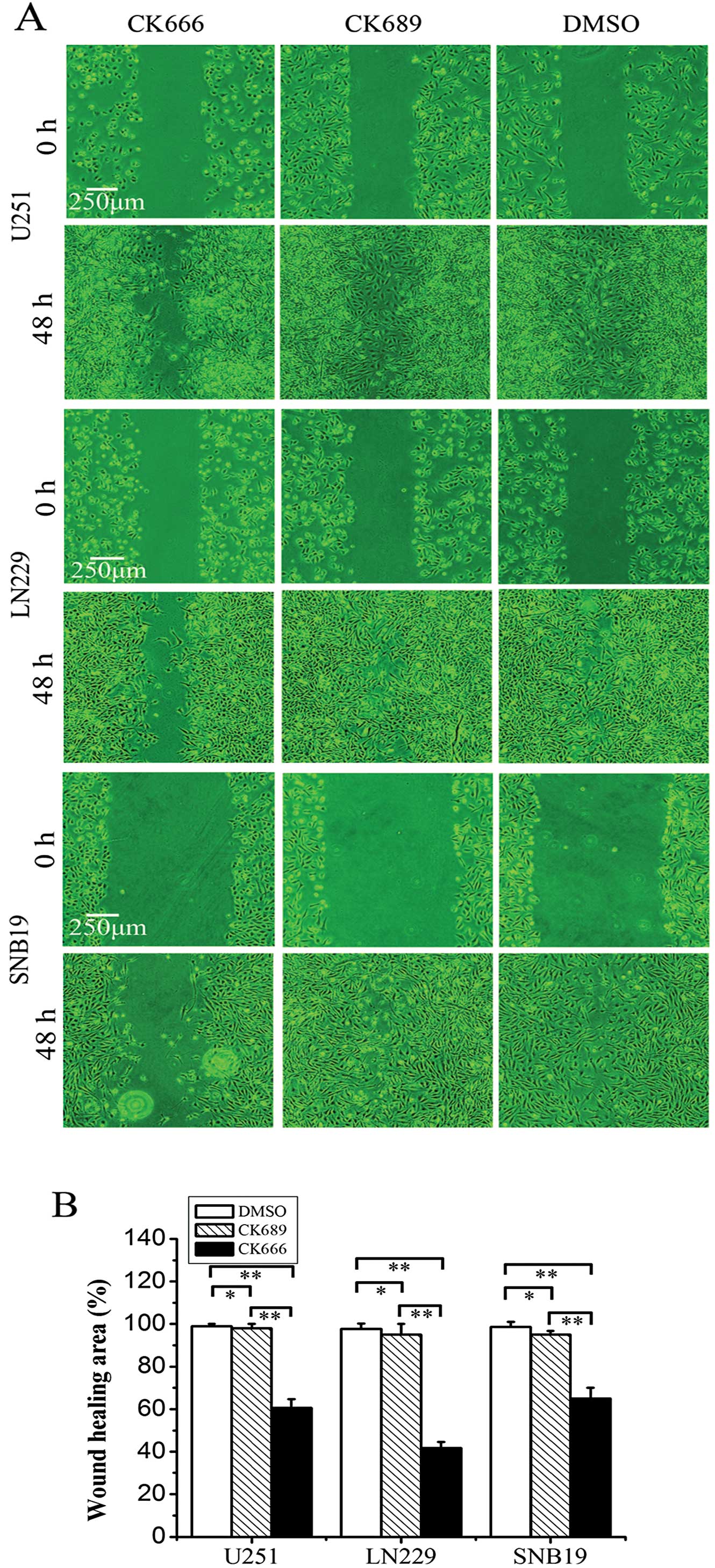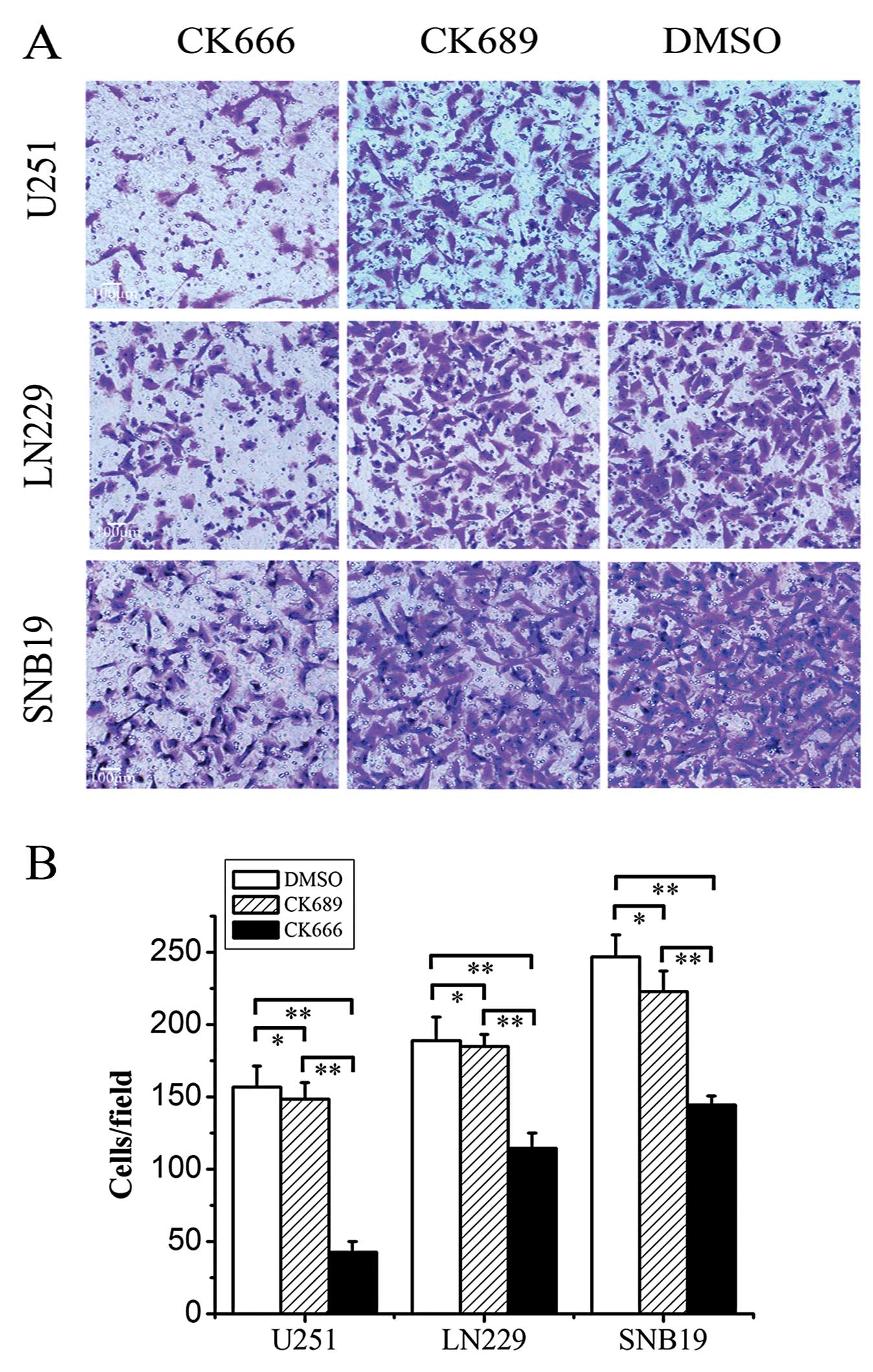Expression of the Arp2/3 complex in human gliomas and its role in the migration and invasion of glioma cells
- Authors:
- Published online on: August 20, 2013 https://doi.org/10.3892/or.2013.2669
- Pages: 2127-2136
Abstract
Introduction
Glioblastoma multiforme (GBM) is one of the most common and malignant central nervous system (CNS) tumors in humans. Median survival of patients with GBM is usually less than 1 year from the time of diagnosis, and most patients die within 2 years even in the most favorable circumstances (1–3). Despite recent advances in diagnostics and clinical management regimens, the prognosis for patients suffering from malignant glioma remains very poor (4,5). One important reason for treatment failure is the uncontrollable invasion and migration of glioma cells, which ultimately leads to diffuse growth and recurrence of the tumor. Therefore, new therapeutic strategies that effectively control the invasion and migration behavior of glioma cells are urgently required.
The Arp2/3 complex contains seven-subunit proteins and plays a major role in the regulation of the actin cytoskeleton. It consists of actin-related protein-2 (ARP2), ARP3, actin-related protein complex-1 (ARPC1) (p40), ARPC2 (p34), ARPC3 (p21), ARPC4 (p20) and ARPC5 (p16). The activation of the Arp2/3 complex increases its binding to the sides of actin filaments and induces the formation of an actin branch, which grows and is considered to push against the plasma membrane causing lamellipodial protrusions, which are predicted to be critical for cell motility (6–10).
In mammalian cells, the Arp2/3 complex requires activation by nucleation promoting factors (NPFs). When engaged by NPFs, it is activated to initiate the formation of a new (daughter) filament that emerges from an existing (mother) filament in a y-branch configuration with a regular 70° branch angle. NPFs are grouped into 2 categories. Type I NPFs, such as Wiskott-Aldrich syndrome protein (WASP) and suppressor of cyclic AMP repressor [SCAR; also known as WASP-family verprolin-homologous protein (WAVE); there are 3 WAVE homologues, WAVE1, WAVE2 and WAVE3, with WAVE2 being crucial for lamellipodium formation] directly activate the Arp2/3 complex by inducing conformational changes in the complex and supplying the first actin monomer of the new filament. Type II NPFs, such as cortactin, are weaker NPFs on their own but potently synergize with type I NPFs (11,12). In addition, the signal transduction pathways of Rho-family GTPases, CDC42 and Rac, can activate NPFs (9).
In addition to its role in lamellipodia, the Arp2/3 complex also functions in other important processes. In mouse oocytes, the Arp2/3 complex takes part in maintenance of asymmetric meiotic spindle position (13) and Arp2/3-dependent actin nucleation promotes nuclear movements in the zygote. Notably, WAVE and Arp2/3 support MT organization in plants (14). In S. cerevisiae and S. pombe, inactivating or deleting genes that encode subunits of the Arp2/3 complex causes severe growth defects or lethality (6,15,16,18), while knockdown of Arp2/3 subunits in C. elegans affects ventral enclosure in the developing worm and results in lethality (19). Inactivation of Arpc3 in human HeLa cells by RNAi is lethal (20) and disrupting the activity of the Arp2/3 complex and its activators in yeasts or mammalian cells can affect endocytosis (21–25).
Previous data have confirmed the role of the Arp2/3 complex in metastases of non-CNS tumors, and cell migration and invasion were significantly reduced after Arp2/3 complex disruption by RNA interference (26). Moreover, Suraneni et al(27) found that Arp2/3 complex played a critical role in the lamellipodia extension and directional fibroblast migration and Mariani et al(28) found that Arp2/3 was upregulated in migrating glioma cells. However, it is unknown whether the Arp2/3 complex is also functionally important in glioma cells for lamellipodial protrusions and cell movement. In this study, we investigated the role of the Arp2/3 complex in the morphology and motility of glioma cells. We found that inhibition of the Arp2/3 complex by CK666 caused a significant reduction in migration and invasion of human glioma cells.
Materials and methods
Reagents and specimens
The following reagents were used in this study. p34-Arc antibody (Millipore, CA, USA), which was specific for the Arp2/3 complex (in the former research, p34-Arc was usually mentioned as 1 subunit of ARP2/3 complex, and we did not find any literature mentioning the freely available p34-Arc); rhodamine phalloidin (Invitrogen Life Technologies, Carlsbad, CA, USA), used for actin staining; Alexa Fluor 488 and 555-conjugated secondary antibodies (Invitrogen Life Technologies); Triton X-100 (Solarbio, Beijing, China); 4% paraformaldehyde (Solarbio); CK666 (inhibitor of the Arp2/3 complex) and CK689 (inactive control of CK666) (Merck KGaA, Darmstadt, Germany), which were dissolved in dimethyl sulfoxide (DMSO) (Solarbio); DAPI (Sigma, St. Louis, MO, USA); MTT (Sigma).
Fifty tumor specimens were obtained from patients with glioma by surgical resection in the Department of Neurosurgery, Tianjin Medical University General Hospital from July 2011 to December 2012. None of these patients had undergone radiation or chemotherapy before surgical therapy. The pathological diagnosis and grading for each glioma was assessed by neuropathologists according to the 2007 World Health Organization (WHO) Classification of Nervous System Tumors. Glioma specimens included 8 cases of pilocytic astrocytoma (WHO grade I), 6 cases of diffuse astrocytoma (WHO grade II), 8 cases of oligoastrocytoma (WHO grade II), 10 cases of anaplastic oligodendroglioma (WHO grade III) and 18 cases of glioblastoma (WHO grade IV). Eight specimens of non-tumor brain tissue were obtained from patients undergoing craniotomy for epilepsy. All tissue samples were collected in accordance with institutional review board-approved protocols. After surgical resection, tissue specimens were immediately frozen and stored in liquid nitrogen until use. This study was approved by the institutional review boards of Tianjin Medical University General Hospital and written informed consent was obtained from all patients.
Cell culture
Human glioma cell lines, U251, LN229 and SNB19, were purchased from the Chinese Academy of Sciences Cell Bank. U251, LN229 and SNB19 cells were cultured in Dulbecco’s modified Eagle’s medium (DMEM) supplemented with 10% fetal bovine serum (FBS) (Solarbio), and maintained at 37°C in an atmosphere of 5% CO2 and routinely passaged at 2–3 day intervals.
Immunohistochemistry assay
Frozen sections were fixed, washed with PBS and incubated in 5% bovine serum albumin (BSA) to block non-specific binding, sections were then incubated with p34-Arc antibodies (rabbit) at a dilution of 1:100 overnight at 4°C, washed in PBS, and then incubated with Alexa 555-conjugated goat anti-rabbit secondary antibody at a dilution of 1:1,000 for 1 h at 37°C. Cell nuclei were stained by DAPI. Immunofluorescence was visualized using a fluorescence microscope (Olympus DP70, Tokyo, Japan).
Western blot analysis
For each specimen, 50 mg of tissue was broken into small pieces and transferred into a 1.5 ml microcentrifuge tube. A total of 500 μl cell lysis buffer was added to the tube. The tissue was homogenized on ice with 10–15 strokes (3–4 sec/stroke) of a mini-homogenizer and plastic pestle. The sample was centrifuged at 12,000 × g for 15 min at 4°C and the supernatant then transferred to a fresh tube. A total of 50 μg protein and an equal volume of 2X sample buffer were heated at 94°C for 5 min. Proteins were separated on an 8% sodium dodecyl sulfate-polyacrylamide gel and then transblotted onto a polyvinylidene difluoride (PVDF) transfer membrane. The blot was blocked in PBST and 5% skimmed dried milk at 37°C for 1 h. The membrane was then incubated in primary antibody (p34, rabbit, 1:1,000) at 4°C overnight, followed by treatment with mouse anti-rabbit secondary antibody (1:5,000). Blots were developed using enhanced chemiluminescence (ECL) reagents (Amersham Pharmacia, UK) and visualized using the GeneGenius Imaging System (Frederick, MD, USA). p34-Arc antibody was used to detect the expression of Arp2/3 and β-actin was used as the internal standard.
MTT assay
Briefly, tumor cells (5,000 cells/well) were seeded in 96-well plates. After 24 h, a different concentration of CK666, CK689 (50, 100 and 150 μM) or DMSO (0.4, 0.8 and 1.2 μl/ml) was added to the cells for 0.5–4 h, then followed by a washout. Cells were then incubated in fresh medium for an additional 48 h. A total of 20 μl of MTT labeling reagent was then added to each well containing cells in 150 μl of medium, and cells were incubated for 4 h at 37°C in a CO2 incubator to allow the MTT to be metabolized. The medium was then removed and 200 μl of DMSO was added to each well to dissolve the formazan. The absorbance of the samples was measured at a wavelength of 570 nm by a microplate reader. Percent viability was calculated relative to DMSO treated cells.
Confocal microscopy analysis of F-actin
Glioma cells were grown on glass coverslips for 24–48 h. The cells were preincubated with CK666 (100 μM), CK689 (100 μM) or DMSO (0.8 μl/ml) for 30 min, washed and then fixed with 4% paraformaldehyde for 25 min. Fixed cells were permeabilized by treatment with 0.5% Triton X-100 for 5 min and blocked by incubation with 5% BSA in PBS for 1 h. Cells were then incubated overnight at 4°C with p34-Arc antibodies at a dilution of 1:100. Cells were washed 3 times with PBS and then incubated for 1 h with Alexa 488-conjugated goat anti-rabbit secondary antibody at a dilution of 1:1,000 for 1 h at 37°C. Cells were washed with PBS and then counterstained with rhodamine phalloidin for 20 min to stain actin filaments and DAPI to stain DNA. The cells were imaged under a confocal microscope (Olympus FV1000S, Japan).
Morphological analysis and wound-healing assays
Glioma cells (1.0×105 cells/ml) were seeded in 6-well plates and allowed to spread for 24 h. Then cells in different wells were treated with CK666 (100 μM), CK689 (100 μM) or DMSO. The changes in morphology were recorded by a microscope (Olympus, Japan) equipped with a 37°C, 5% CO2 incubator for a period of 30 min with frames captured every 2 min.
For the wound-healing assay, glioma cells were seeded in 6-well plates at a density of 2.0×105 cells/ml and allowed to reach confluency. Before a confluent monolayer was obtained, cells in different wells were preincubated with CK666 (100 μM), CK689 (100 μM) or DMSO for 30 min, and then wounds were created using a 200 μl sterile pipette tip. Subsequently, cell debris was removed by washing the plates twice with PBS and fresh DMEM supplemented with 3% FBS was added to each well. The cells were further cultivated for up to 48 h. The wound healing area was recorded by taking photomicrographs at different time points.
Transwell invasion assay
Glioma cells were preincubated with CK666 (100 μM), CK689 (100 μM) or DMSO for 30 min, and then seeded in the top chamber of a Matrigel-coated Boyden chamber (Millipore, USA) at 5.0×104 cells/well without serum. DMEM (600 μl) with 10% FBS was added to the lower chamber as chemoattractant. Following incubation for 48 h, non-invading cells were removed from the top chamber with a cotton swab. The cells on the lower surface were fixed by replacing the culture medium in the bottom with 4% formaldehyde. After fixation for 15 min at room temperature, the chambers were rinsed in PBS and stained with 0.2% crystal violet for 10 min. For each experimental condition, 10 image fields were photographed and quantified.
Statistical analysis of data
Statistical analyses were carried out using SPSS 17.0 (Chicago, IL, USA). One-way analysis of variance (ANOVA), least significant difference and Pearson’s correlation tests were used. P<0.05 was considered to indicate statistically significant differences. Values are expressed as means ± standard deviation (SD). All in vitro experiments were repeated 3 times.
Results
Arp2/3 complex expression in human gliomas
Hematoxylin and eosin (H&E) staining was performed to confirm the WHO grading of the tumors. To determine Arp2/3 complex expression in human gliomas, both immunofluorescence and western blot analysis were employed. Immunofluorescence of frozen tissue sections revealed that the Arp2/3 complex was localized at the cell cytoplasm, and its fluorescence intensity increased with increasing tumor malignancy (Fig. 1A). Semi-quantitative assessment of Arp2/3 complex levels by western blot analysis validated the immunofluorescence results (Fig. 1B). Relative to β-actin, the level of Arp2/3 in tissue specimens was 15.69±1.04% in non-tumor brain tissue (NB, n=8), 31.17±4.30% in WHO grade I (n=8), 40.51±2.12% in WHO grade II (n=14), 48.68±2.69% in WHO grade III (n=10) and 55.42±3.45% in WHO grade IV (n=18) (Fig. 1C). The expression of Arp2/3 in the glioma specimens was significantly higher than in non-tumor brain tissue (P<0.05) and there was a positive correlation between the expression of Arp2/3 and the malignancy of glioma specimens (r=0.686, P=0.02). These data indicate that levels of the Arp2/3 complex may be involved in malignant progression of glioma, including tumor cell migration and invasion.
Effects of inhibiting the Arp2/3 complex on cell survival and proliferation
The MTT assay, which is widely used to measure cell survival and proliferation, is based on reduction of the tetrazolium salt, 3-(4,5-dimethylthiazol-2-yl)-2,5-diphenyltetrazolium bromide (MTT) by actively growing cells to produce a blue formazan product (29,30). To analyze the effects of the Arp2/3 complex inhibitor, CK666, on survival and proliferation of U251, LN229 and SNB19 human glioma cells, we performed an MTT assay (Fig. 2). CK689 and DMSO served as an inactive compound control and a solvent control, respectively. Glioma cells were preincubated with CK666, CK689 or DMSO for 0.5–4 h. The viability and proliferation of glioma cells was not clearly impaired (P<0.05) by treatment with CK666 (50 or 100 μM) for 30 min, but decreased gradually when treated for over 30 min or even within 30 min when the drug concentration was 150 μM, compared with inactive and solvent control. This observation demonstrated that CK666 (50 or 100 μM) treatment for 30 min had no immediate cytotoxic effect on human glioma cells. In the subsequent experiment, we chose the higher drug concentration, 100 μM, to treat the glioma cells.
The Arp2/3 complex is localized in lamellipodia of glioma cells
To determine the localization of the Arp2/3 complex in lamellipodia, U251, LN229 and SNB19 cells were treated with CK666 (100 μM), CK689 (100 μM) or DMSO (0.8 μl/ml) for 30 min, then fixed and stained with rhodamine phalloidin for actin and a p34-Arc subunit antibody, specific for the Arp2/3 complex (Fig. 3). Phalloidin staining of cells treated with CK689 or DMSO showed typical lamellipodia, with F-actin enriched at it. Staining with the anti-p34 antibody confirmed that the Arp2/3 complex was also localized in the actin-rich lamellipodia. By contrast, these staining patterns were absent in CK666-treated cells, suggesting that these protrusions may be formed through Arp2/3 complex-mediated actin assembly and that CK666 could inhibit the action of the Arp2/3 complex.
Inhibition of the Arp2/3 complex alters the morphology of glioma cells
Culture-activated glioma cells developed spreading lamellipodia and formed stress fibers. When treated with CK666 (100 μM) for 30 min, lamellipodia became increasingly smaller and finally disappeared (Fig. 4). Notably, CK666 treatment caused an attenuation of cell polarity. No such changes were observed in CK689- or DMSO-treated cells. Twelve hours after the cell culture medium was refreshed with DMEM supplemented with 10% FBS, cells recovered their morphology (data not shown). Overall, our results confirmed the obligate role of the Arp2/3 complex in generating densely branched actin networks/lamellipodia in human glioma cells.
Inhibition of the Arp2/3 complex reduces motility of human glioma cells
The wound-healing assay was one of the first methods to be developed to study cell migration in vitro. Although not an exact duplication of cell migration in vivo, this method mimics to some extent migration of cells in wound healing. To evaluate the inhibitory effect of CK666 on migration, we performed the assay using human glioma cell lines (Fig. 5). Wound closure was monitored by capturing photomicrographs at 0 and 48 h after wound creation. CK666 pretreatment markedly inhibited U251 cell migration to 38.73±3.45% of control, LN229 cells to 57.40±2.16% of control and SNB19 cells to 34.17±3.82% of control. These data suggested that inhibition of the Arp2/3 complex by CK666 effectively reduced cell migration in all 3 human glioma cell lines.
Part of the invasion cascade involves tumor cells attaching to and penetrating basement membranes. Therefore, basement membranes are critical barriers to the passage of disseminating tumor cells. The Transwell chamber with Matrigel has been used to evaluate the invasive capability of tumor cells (31). Since both cell migration and invasion are critical properties for the diffuse growth of gliomas, we further investigated the role of CK666 in suppressing tumor cell invasion using the Transwell invasion assay (Fig. 6). CK666 significantly impaired the invasion of U251, LN229 and SNB19 glioma cells across the Transwell chamber compared with DMSO by 72.70±4.86 (P<0.05), 39.12±8.42 (P<0.05) and 41.41±4.66% (P<0.05), respectively (Fig. 6B).
These data strongly indicate that the Arp2/3 complex plays an important role in glioma cell migration and invasion, and that an Arp2/3 complex inhibitor, targeting lamellipodial actin assembly, is a potential treatment strategy for glioma.
Discussion
In the current study, we investigated the Arp2/3 complex in 3 glioma cell lines using the inhibitor CK666. Our results demonstrated that the Arp2/3 complex may play an important role in human glioblastoma progression and suggested that targeting the Arp2/3 complex may be a potential anticancer strategy to treat glioma.
Cancer metastasis is the leading cause of mortality in most cancer patients due to tumor burden and organ dysfunction. The central, defining process of cancer metastasis is the ability of tumor cells to mobilize, invade and cross normally non-permissive tissue barriers. During cancer metastasis, tumor cells gain the ability to migrate throughout the body, seed and proliferate in distant organs to establish secondary tumors within normal tissues (32). Cell migration away from the site of the primary tumor is a hallmark of malignant cancer metastasis, often leading to recurrence and the failure of existing therapies. This is particularly evident in malignant gliomas, which are the most challenging tumor of the central nervous system, characterized by an ability to disperse through normal neural tissue and recur after initial treatment (33,34). Histological evidence has shown that glioma cell dispersal in the brain occurs along preferential patterns, in many cases following the orientation of thin, elongated anatomical structures, such as capillaries, white matter fibers, and unmyelinated axons (35,36).
The biological features of aggressive infiltration into adjacent tissues generally make glioblastoma incurable, even in the absence of overt metastasis. Complete resection is virtually impossible due to the infiltrative nature of the disease (37,38), while conventional adjuvant therapies such as chemotherapy and radiotherapy may in fact trigger glioma cell dispersion (39,40). In addition, motile glioma cells are also more resistant than non-motile cells to apoptotic stimuli (30,41). Gliomas produce few metastases in extracranial organs, which is different from tumors in other organs that are prone to distant metastasis. If the control of migration/invasion of glioma cells can be realized, it may open the door for other directed therapies against an anatomically-restricted neoplasia.
Over the past decades, marked progress has been made in our understanding of the mechanisms of cell migration. In general, cell migration involves leading edge protrusion (42,43) and adhesion to the extracellular matrix (ECM), cell body translocation, and posterior retraction (6,21,44). In the migrating cell, the leading edge contains 2 types of actin structure: branched networks of actin filaments that form lamellipodia and parallel bundles that form filopodia (45). Lamellipodia are sheet-like protrusions that contain a distinctive, extensively branched network of actin filaments and they are the main cellular engine for locomotion. Filopodia, meanwhile, are believed to be sensory and guidance organelles, responsible for ‘intelligent’ cell behavior (46,47). In lamellipodia, activation of the Arp2/3 complex nucleates new filaments on the side of preexisting F-actin filaments. The barbed ends of the actin filaments in this dendritic network push against the membrane at the leading edge and generate protrusive force by polymerization (48–50).
Arp2/3 mRNA and protein levels, together with those of N-WASP, WAVE2 and other factors that are functionally associated with cell motility, are upregulated in some tumor tissues and invasive cells. Breast cancer cells expressing both WAVE2 and the Arp2/3 complex frequently appear at the invasive front, and coexpression of both has been shown to be correlated with poor clinical outcome (12). In this study, we detected Arp2/3 complex expression in human glioma tissues (WHO grade I–IV) and non-tumor brain tissues by immunofluorescent staining and western blot analysis. The expression level of the Arp2/3 complex was higher in gliomas than in non-tumor brain tissues and this elevation was strongly correlated with the tumor grades. Gliomas of higher grade are generally easier dispersed through normal neural tissue and have more opportunities to recur after initial treatment, thus patients with higher-grade gliomas often have a poor prognosis. This may be ascribed to glioma cells of higher-grade that have stronger capability of motility. However, lamellipodia play a critical role in the cell movement and the Arp2/3 complex mediates the formation of lamellipodia. We hypothesized that Arp2/3 complex is closely related to the cell motility and further selected 3 human glioma cell lines to determine whether the Arp2/3 complex was functionally important for cell migration in glioma cells. We first found the Arp2/3 complex is localized to lamellipodia of glioma cells through the immunofluorescence.
The subsequent steps in this study were designed to investigate whether lamellipodia and actin formation could be suppressed if we treated glioma cells with an Arp2/3 complex inhibitor and how migration and invasion of glioma cells was consequently affected. Wu et al(51) microinjected bovine Arp2/3 complex into Arp2/3-inhibited cells, and observed the reappearance of lamellipodia within 20 min after injection. Their experiment supplied evidence that the lack of lamellipodia was solely due to the absence of Arp2/3 activity. The inhibitor of Arp2/3 complex mentioned for the first time is CK636 and CK548. However, CK666 and CK869 are more potent inhibitors related to CK636 and CK548. In particular, CK666 is a better choice to inhibit the Arp2/3 complex, which binds between Arp2 and Arp3, blocking the formation of an active conformation (52). Our study demonstrated that inhibition of Arp2/3 function by CK666 led to the disappearance of lamellipodia and the significant inhibition of migration and invasion capability of glioma cells. These results were consistent with previous findings in melanoblasts (51,53). The data indicated that CK666 showed moderate effect in U251 migration. However, it showed highest effect in U251 invasion. In the invasion assay, there were more factors involved in the process of cell movement except the lamellipodia, such as matrix metalloproteinases (MMPs). MMPs may have a more important role in the LN229 and SNB19 invasion assay than in the U251 invasion assay. This required further investigation. In addition to the effects of CK666 on lamellipodia, we also found it affected the polarization of glioma cells, which is also a requirement for cellular movement (43,54,55).
In summary, the Arp2/3 complex is known to play a crucial role in the formation of lamellipodia. Our data show that the Arp2/3 complex is overexpressed in human gliomas and is involved in the regulation of glioma cell morphology and motility. Inhibition of Arp2/3 reduced the migration rate and altered the morphology of glioma cells. These findings encourage us to further evaluate the role of the Arp2/3 complex in glioma cell migration and provide a basis for developing Arp2/3 complex therapeutic targets to inhibit glioma cell dissemination. In future studies, we will further assess the role of Arp2/3 complex activators, such as WAVE, in the motility of glioma cells, not only in vitro but also in vivo. Cell motility in vivo may also involve invadopodia, which are actin-rich membrane protrusions formed by invasive cancer cells and mediate the focal degradation of pericellular ECM by the localized proteolytic activity of MMPs. However, actin polymerization in invadopodia is also dependent on Arp2/3 (56,57). Targeting motility may improve therapy of glioma by preventing further infiltration and expansion into normal brain tissues.
Acknowledgements
This study was supported by a grant from the National Natural Science Foundation of China (no. 81272782).
References
|
Kim KJ, Lee KH, Kim HS, Moon KS, Jung TY, Jung S and Lee MC: The presence of stem cell marker-expressing cells is not prognostically significant in glioblastomas. Neuropathology. 31:494–502. 2011. View Article : Google Scholar : PubMed/NCBI | |
|
Buckner JC: Factors influencing survival in high-grade gliomas. Semin Oncol. 30(Suppl 19): 10–14. 2003. View Article : Google Scholar | |
|
Peterson K: Brain tumors. Neurol Clin. 19:887–902. 2001. View Article : Google Scholar | |
|
Sathornsumetee S and Rich JN: New treatment strategies for malignant gliomas. Expert Rev Anticancer Ther. 6:1087–1104. 2006. View Article : Google Scholar | |
|
Sathornsumetee S and Rich JN: Designer therapies for glioblastoma multiforme. Ann NY Acad Sci. 1142:108–132. 2008. View Article : Google Scholar : PubMed/NCBI | |
|
Morrell JL, Morphew M and Gould KL: A mutant of Arp2p causes partial disassembly of the Arp2/3 complex and loss of cortical actin function in fission yeast. Mol Biol Cell. 10:4201–4215. 1999. View Article : Google Scholar : PubMed/NCBI | |
|
Pollard TD and Cooper JA: Actin, a central player in cell shape and movement. Science. 326:1208–1212. 2009. View Article : Google Scholar : PubMed/NCBI | |
|
Liao G, Simone B and Liu G: Mis-localization of Arp2 mRNA impairs persistence of directional cell migration. Exp Cell Res. 317:812–822. 2011. View Article : Google Scholar : PubMed/NCBI | |
|
Pollard TD: Regulation of actin filament assembly by Arp2/3 complex and formins. Annu Rev Biophys Biomol Struct. 36:451–477. 2007. View Article : Google Scholar : PubMed/NCBI | |
|
Goley ED and Welch MD: The ARP2/3 complex: an actin nucleator comes of age. Nat Rev Mol Cell Biol. 7:713–726. 2006. View Article : Google Scholar : PubMed/NCBI | |
|
Cai L, Makhov AM, Schafer DA and Bear JE: Coronin 1B antagonizes cortactin and remodels Arp2/3-containing actin branches in lamellipodia. Cell. 134:828–842. 2008. View Article : Google Scholar : PubMed/NCBI | |
|
Yokotsuka M, Iwaya K, Saito T, Pandiella A, et al: Overexpression of HER2 signaling to WAVE2-Arp2/3 complex activates MMP-independent migration in breast cancer. Breast Cancer Res Treat. 126:311–318. 2011. View Article : Google Scholar : PubMed/NCBI | |
|
Yi K, Unruh JR, Deng M, Slaughter BD, Rubinstein B and Li R: Dynamic maintenance of asymmetric meiotic spindle position through Arp2/3-complex-driven cytoplasmic streaming in mouse oocytes. Nat Cell Biol. 13:1252–1258. 2011. View Article : Google Scholar : PubMed/NCBI | |
|
Xiong H, Mohler WA and Soto MC: The branched actin nucleator Arp2/3 promotes nuclear migrations and cell polarity in the C. elegans zygote. Dev Biol. 357:356–369. 2011. View Article : Google Scholar : PubMed/NCBI | |
|
Lees-Miller JP, Henry G and Helfman DM: Identification of act2, an essential gene in the fission yeast Schizosaccharomyces pombe that encodes a protein related to actin. Proc Natl Acad Sci USA. 89:80–83. 1992. View Article : Google Scholar : PubMed/NCBI | |
|
Winter D, Podtelejnikov AV, Mann M and Li R: The complex containing actin-related proteins Arp2 and Arp3 is required for the motility and integrity of yeast actin patches. Curr Biol. 7:519–529. 1997. View Article : Google Scholar : PubMed/NCBI | |
|
Winter DC, Choe EY and Li R: Genetic dissection of the budding yeast Arp2/3 complex: a comparison of the in vivo and structural roles of individual subunits. Proc Natl Acad Sci USA. 96:7288–7293. 1999. View Article : Google Scholar : PubMed/NCBI | |
|
Balasubramanian MK, Feoktistova A, McCollum D and Gould KL: Fission yeast Sop2p: a novel and evolutionarily conserved protein that interacts with Arp3p and modulates profilin function. EMBO J. 15:6426–6437. 1996.PubMed/NCBI | |
|
Sawa M, Suetsugu S, Sugimoto A, Miki H, Yamamoto M and Takenawa T: Essential role of the C. elegans Arp2/3 complex in cell migration during ventral enclosure. J Cell Sci. 116:1505–1518. 2003. | |
|
Harborth J, Elbashir SM, Bechert K, Tuschl T and Weber K: Identification of essential genes in cultured mammalian cells using small interfering RNAs. J Cell Sci. 114:4557–4565. 2001.PubMed/NCBI | |
|
Mendoza MC, Er EE, Zhang W, Ballif BA, Elliott HL, Danuser G and Blenis J: ERK-MAPK drives lamellipodia protrusion by activating the WAVE2 regulatory complex. Mol Cell. 41:661–671. 2011. View Article : Google Scholar : PubMed/NCBI | |
|
Moreau V, Galan JM, Devilliers G, Haguenauer-Tsapis R and Winsor B: The yeast actin-related protein Arp2p is required for the internalization step of endocytosis. Mol Biol Cell. 8:1361–1375. 1997. View Article : Google Scholar : PubMed/NCBI | |
|
Schaerer-Brodbeck C and Riezman H: Functional interactions between the p35 subunit of the Arp2/3 complex and calmodulin in yeast. Mol Biol Cell. 11:1113–1127. 2000. View Article : Google Scholar : PubMed/NCBI | |
|
Jonsdottir GA and Li R: Dynamics of yeast Myosin I: evidence for a possible role in scission of endocytic vesicles. Curr Biol. 14:1604–1609. 2004. View Article : Google Scholar : PubMed/NCBI | |
|
Benesch S, Polo S, Lai FP, Anderson KI, Stradal TE, Wehland J and Rottner K: N-WASP deficiency impairs EGF internalization and actin assembly at clathrin-coated pits. J Cell Sci. 118:3103–3115. 2005. View Article : Google Scholar : PubMed/NCBI | |
|
Laurila E, Savinainen K, Kuuselo R, Karhu R and Kallioniemi A: Characterization of the 7q21–q22 amplicon identifies ARPC1A, a subunit of the Arp2/3 complex, as a regulator of cell migration and invasion in pancreatic cancer. Genes Chromosomes Cancer. 48:330–339. 2009. | |
|
Suraneni P, Rubinstein B, Unruh JR, Durnin M, Hanein D and Li R: The Arp2/3 complex is required for lamellipodia extension and directional fibroblast cell migration. J Cell Biol. 197:239–251. 2012. View Article : Google Scholar : PubMed/NCBI | |
|
Mariani L, Beaudry C, McDonough WS, et al: Glioma cell motility is associated with reduced transcription of proapoptotic and proliferation genes: a cDNA microarray analysis. J Neurooncol. 53:161–176. 2001. View Article : Google Scholar : PubMed/NCBI | |
|
Imamura H, Takao S and Aikou T: A modified invasion-3-(4,5-dimethylthiazole-2-yl)-2,5-diphenyltetrazolium bromide assay for quantitating tumor cell invasion. Cancer Res. 54:3620–3624. 1994.PubMed/NCBI | |
|
Berridge MV and Tan AS: Characterization of the cellular reduction of 3-(4,5-dimethylthiazol-2-yl)-2,5-diphenyltetrazolium bromide (MTT): subcellular localization, substrate dependence, and involvement of mitochondrial electron transport in MTT reduction. Arch Biochem Biophys. 303:474–482. 1993. View Article : Google Scholar | |
|
Repesh LA: A new in vitro assay for quantitating tumor cell invasion. Invasion Metastasis. 9:192–208. 1989.PubMed/NCBI | |
|
Wu TL and Zhou D: Viral delivery for gene therapy against cell movement in cancer. Adv Drug Deliv Rev. 63:671–677. 2011. View Article : Google Scholar : PubMed/NCBI | |
|
Wen PY and Kesari S: Malignant gliomas in adults. N Engl J Med. 359:492–507. 2008. View Article : Google Scholar : PubMed/NCBI | |
|
Agudelo-Garcia PA, De Jesus JK, Williams SP, et al: Glioma cell migration on three-dimensional nanofiber scaffolds is regulated by substrate topography and abolished by inhibition of STAT3 signaling. Neoplasia. 13:831–840. 2011.PubMed/NCBI | |
|
Louis DN: Molecular pathology of malignant gliomas. Annu Rev Pathol. 1:97–117. 2006. View Article : Google Scholar | |
|
Yu SP, Yang XJ, Zhang B, et al: Enhanced invasion in vitro and the distribution patterns in vivo of CD133+ glioma stem cells. Chin Med J (Engl). 124:2599–2604. 2011.PubMed/NCBI | |
|
Brandes AA, Tosoni A, Franceschi E, Reni M, Gatta G and Vecht C: Glioblastoma in adults. Crit Rev Oncol Hematol. 67:139–152. 2008. View Article : Google Scholar | |
|
Stark AM, van de Bergh J, Hedderich J, Mehdorn HM and Nabavi A: Glioblastoma: clinical characteristics, prognostic factors and survival in 492 patients. Clin Neurol Neurosurg. 114:840–845. 2012. View Article : Google Scholar : PubMed/NCBI | |
|
Lamszus K, Kunkel P and Westphal M: Invasion as limitation to anti-angiogenic glioma therapy. Acta Neurochir Suppl. 88:169–177. 2003.PubMed/NCBI | |
|
Zhai GG, Malhotra R, Delaney M, et al: Radiation enhances the invasive potential of primary glioblastoma cells via activation of the Rho signaling pathway. J Neurooncol. 76:227–237. 2006. View Article : Google Scholar : PubMed/NCBI | |
|
Joy AM, Beaudry CE, Tran NL, Ponce FA, Holz DR, Demuth T and Berens ME: Migrating glioma cells activate the PI3-K pathway and display decreased susceptibility to apoptosis. J Cell Sci. 116:4409–4417. 2003. View Article : Google Scholar : PubMed/NCBI | |
|
Hanisch J, Kolm R, Wozniczka M, Bumann D, Rottner K and Stradal TE: Activation of a RhoA/myosin II-dependent but Arp2/3 complex-independent pathway facilitates Salmonella invasion. Cell Host Microbe. 9:273–285. 2011. View Article : Google Scholar : PubMed/NCBI | |
|
Shao D, Levine H and Rappel WJ: Coupling actin flow, adhesion, and morphology in a computational cell motility model. Proc Natl Acad Sci USA. 109:6851–6856. 2012. View Article : Google Scholar : PubMed/NCBI | |
|
Insall RH and Machesky LM: Actin dynamics at the leading edge: from simple machinery to complex networks. Dev Cell. 17:310–322. 2009. View Article : Google Scholar : PubMed/NCBI | |
|
Campellone KG, Webb NJ, Znameroski EA and Welch MD: WHAMM is an Arp2/3 complex activator that binds microtubules and functions in ER to Golgi transport. Cell. 134:148–161. 2008. View Article : Google Scholar : PubMed/NCBI | |
|
Svitkina TM and Borisy GG: Arp2/3 complex and actin depolymerizing factor/cofilin in dendritic organization and treadmilling of actin filament array in lamellipodia. J Cell Biol. 145:1009–1026. 1999. View Article : Google Scholar : PubMed/NCBI | |
|
Vignjevic D and Montagnac G: Reorganisation of the dendritic actin network during cancer cell migration and invasion. Semin Cancer Biol. 18:12–22. 2008. View Article : Google Scholar : PubMed/NCBI | |
|
Watanabe N: Inside view of cell locomotion through single-molecule: fast F-/G-actin cycle and G-actin regulation of polymer restoration. Proc Jpn Acad Ser B Phys Biol Sci. 86:62–83. 2010. View Article : Google Scholar : PubMed/NCBI | |
|
Mullins RD, Heuser JA and Pollard TD: The interaction of Arp2/3 complex with actin: nucleation, high affinity pointed end capping, and formation of branching networks of filaments. Proc Natl Acad Sci USA. 95:6181–6186. 1998. View Article : Google Scholar : PubMed/NCBI | |
|
Mogilner A and Oster G: Cell motility driven by actin polymerization. Biophys J. 71:3030–3045. 1996. View Article : Google Scholar : PubMed/NCBI | |
|
Wu C, Asokan SB, Berginski ME, et al: Arp2/3 is critical for lamellipodia and response to extracellular matrix cues but is dispensable for chemotaxis. Cell. 148:973–987. 2012. View Article : Google Scholar : PubMed/NCBI | |
|
Nolen BJ, Tomasevic N, Russell A, et al: Characterization of two classes of small molecule inhibitors of Arp2/3 complex. Nature. 406:1031–1034. 2009. View Article : Google Scholar : PubMed/NCBI | |
|
Li A, Ma Y, Yu X, et al: Rac1 drives melanoblast organization during mouse development by orchestrating pseudopod-driven motility and cell-cycle progression. Dev Cell. 21:722–734. 2011. View Article : Google Scholar : PubMed/NCBI | |
|
Verkhovsky AB, Svitkina TM and Borisy GG: Self-polarization and directional motility of cytoplasm. Curr Biol. 9:11–20. 1999. View Article : Google Scholar : PubMed/NCBI | |
|
Rottner K and Stradal TE: Actin dynamics and turnover in cell motility. Curr Opin Cell Biol. 23:569–578. 2011. View Article : Google Scholar : PubMed/NCBI | |
|
Sibony-Benyamini H and Gil-Henn H: Invadopodia: the leading force. Eur J Cell Biol. 91:896–901. 2012. View Article : Google Scholar | |
|
Yamaguchi H: Pathological roles of invadopodia in cancer invasion and metastasis. Eur J Cell Biol. 91:902–907. 2012. View Article : Google Scholar : PubMed/NCBI |



